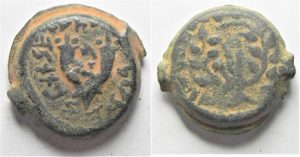Previous posts in this series:
This post needs to be read in conjunction with How Dating the Dead Sea Scrolls Went Awry — #1. We concluded in that post with: “the resetting of the palaeographic dates to conform with artefacts in Qumran was based on three assumptions, all of which were “deeply flawed.”
.
Assumption 1:
All pottery more recent than the Iron Age (age of Assyria, Babylonia, etc) was the product of a settlement in the first century CE era.
Doubts:
The second excavation (1953) uncovered activity from the first century BCE.
Recall that jar embedded in the floor of Locus 2 — it was of the same kind found in Cave 1 with the scrolls.

Coins were found there from the time of Antigonus Mattathias, 40-37 BCE, one right beside that jar.
That jar in Qumran’s Locus 2 was now re-dated to the first century BCE. That is, that room was now BCE, not CE.
But the first century CE date held for the Qumran “community” by arguing that the room was swept clean and re-used through the first century CE by the “community” or people who would be related to the scrolls.
That is, despite the discovery of BCE setting, the CE date for the scrolls failed to budge. 1951 saw the date revised and that revision uncritically held fast despite the new archaeological discoveries.
Although excavator of the site Roland de Vaux belatedly acknowledged in a public lecture that the scroll jars in the caves were indeed from the first century BCE (1959) and eventually published the same point (1962) he never provided specific details. I can imagine that such vagueness did little to prod a critical reevaluation of the widespread acceptance of the first century CE date for the scrolls.
.
Two other assumptions filled the gap left by the awareness of evidence that there was BCE settlement activity and the site was not exclusively CE.
Assumption 2:
(a) A single group controlled and inhabited Qumran throughout the period 150 BCE to 68 CE. (Apart from a short hiatus around the turn of the century.)
(b) Scrolls would have continued to be deposited throughout the entire duration of that settlement — that is, they would have continued to be deposited up to the time of the Jewish War.
Doubts:
This assumption likewise began to crumble:
As is well known, many archaeologists have rejected this second foundational assumption. That is, they reject a Ia/Ib or Ib/II continuity in people and function at Qumran (e.g. Bar Adon, Humbert, Hirschfeld, Magen, Peleg). (Doudna 2017, p. 241)
The following table gives us the idea: Continue reading “Dating the Dead Sea Scrolls — #2”
